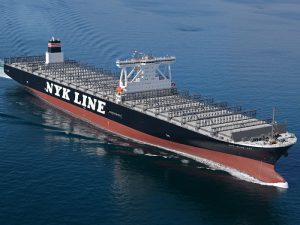
NYK takes delivery of WinGD powered box ship
APRIL 13, 2016 — Winterthur Gas & Diesel (WinGD) reports that shipbuilder Japan Marine United Corporation recently delivered the 14,000 TEU containership NYK Blue Jay. The vessel is the first of

APRIL 13, 2016 — Winterthur Gas & Diesel (WinGD) reports that shipbuilder Japan Marine United Corporation recently delivered the 14,000 TEU containership NYK Blue Jay. The vessel is the first of
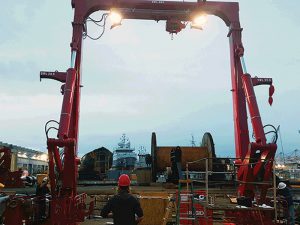
With the goal of improving the safety and capability of the marine research industry, Allied Marine Crane, a division of Allied Systems Company, has developed the A-Stern A-Frame. Hydraulically powered, the A-Frame is used to launch and recover trawls, dredges, and ROVs. Its crossbeam rotates freely as it deploys, ensuring that the load—the unit has a 30,000 to 40,000 lb dynamic load capacity—and lighting are properly oriented throughout the entire range of motion.
Last year, the innovative unit was successfully fitted onto the R/V Sikuliaq. The vessel, owned by the National Science Foundation and operated by the University of Alaska Fairbanks School of Fisheries and Ocean Sciences, conducts oceanographic and fisheries related research in polar and sub-polar regions.
Allied says, the A-30 Stern A-Frame’s maintenance position allows crew to access the crossbeam from the deck at a standing height furthering safety during setup and rigging.
The provider also supplied the U.S. Navy’s Office of Naval Research vessels the 238 ft Neil Armstrong and Sally Ride with two sets of crane components. The Neil Armstrong is being operated by the Woods Hole Oceanographic Institution, while the Sally Ride is currently operating for the Scripps Institution of Oceanography at the University of California San Diego.
Under the contract, the company designed and manufactured an identical set of handling equipment for each vessel. The units consisted of a davit; the Stern A-frame; a telescoping knuckle-boom crane; a starboard side handling system and a CTD handling system—both of which extend all the way to the waterline for more stability when loading; a portable telescoping knuckle-boom crane—among the first of its kind in the industry, the unit can be bolted down to a standard UNOLS mounting pattern anywhere on deck and can be removed when its not needed; and two hydraulic power units.
 BREAKING INTO A NEW NICHE
BREAKING INTO A NEW NICHE
Rapp Marine U.S. has taken a huge innovative step forward, developing, what its President Johann Sigurjonsson calls “an ideal tow winch for the market.” Having long been a developer and supplier of electric and hydraulic driven mooring winches, anchor windlasses, capstans, and cranes, Rapp Marine worked closely with Baydelta Navigation Ltd. to develop a towing winch that would be long lasting and dependable for the tug market.
Rapp Marine is supplying a unique, fully electric driven double drum tow winch for a new 110 ft x 40 ft tractor tug operated by Vessel Chartering LLC, a wholly owned division of Baydelta Navigation Ltd. The tug was designed by Seattle-based Jensen Maritime and will be built at JT Marine Shipyard, Vancouver, WA.
The winch, the first fully electric driven tow winch delivered by Rapp Marine, will be able to pull over 75 tons and use pneumatic cylinders in place of hydraulics—to keep fluid off the deck.
According to Rapp Marine, the winch will be driven by a single 100 hp electric motor with the ability to clutch in and out each winch drum. The clutches and brakes will be actuated remotely through either control panels or manually on the winch.
The winch will be primarily controlled in the wheelhouse using Rapp Marine’s Pentagon Tow Control System, which provides for a more efficient and safer operations for towing vessels. The system includes Auto Tensioning, automated haul-in and pay-out settings, in addition to touchscreen displays showing tension and wire length.
Rapp Marine says the winch can store up to 2,500 ft of 2.5 inches of Steel Wire Rope and 90 ft of 3 inch chain on the storage drum. The unit will also include a 10 HP electric “come home” drive. The drive can be used as a back up if the main motor should fail.
SELF-ALIGNING ESCORT WINCH
No stranger to innovation, the man behind the innovative training tug, the BRAtt, Captain Ron Burchett, and his company, Burchett Marine, recently delivered three new scale model tugs to Warsash Maritime Academy in Southampton, UK.
The 8,000 hp, 42m ASD tug models were equipped with the latest winch technology from JonRie InterTech—including a JonRie’s patented self-aligning escort winch.
During testing of the winch at the Academy, the model was able to stop a 44 ft long containership model at a speed of 10 knots. Captain Burchett will return to the Academy later this summer for Round 3 of testing at the 12 to 15 knot range.
The winch, says JonRie, was redesigned to accommodate a new 3-speed Hagglunds motor—this would allow for faster retrieval speeds. The motor will have the capability to free wheel each individual cam ring which comes complete with JonRie’s Render Blocking enabling render speeds to exceed 120 m/min. The tug’s dynamic stability was further enhanced by the righting lever supplied by the winch.
The winch’s hydraulic braking system is rated for 300 tonnes.
Additionally, the winch, explains JonRie’s Brandon Durar, is bolted to its rotating foundation to help prevent distortion to the drive from welding. The winch also contains a load tension read out system and JonRie’s foot control for a hands-free operation.
MACGREGOR WINS CONTRACTS FOR ESL SHIPPING CARRIERS
MacGregor, part of Cargotec, recently won a contract to deliver hatch covers, cranes, deck machinery and steering gear to two 25,600 dwt dual-fueled handysize bulk carriers being built for Finland’s ESL Shipping at China’s Sinotrans & CSC Shipbuilding Industry Cooperation’s Quingshan shipyard.
As part of the deal, MacGregor will provide three K3030-4 mechanical grab cargo cranes with a safe working load of 30 tonnes at 30 m outreach. Additionally, the group will provide the design and key components package for multi folding-type hatch covers (6+6), electrically-driven Hatlapa deck machinery and Porsgrunn steering gear.
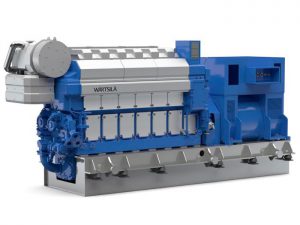
APRIL 8, 2016 — Wärtsilä is to supply Wärtsilä Auxpac 32 generating sets for eight new 13,500 TEU container vessels being built for China Shipping Container Lines (CSCL). Four generating sets are
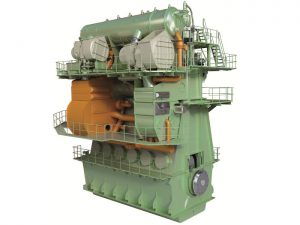
APRIL 5, 2016 – Hyundai’s Ship Building Division (HHI-SBD) has finalized a contract for two Suezmax tankers for Turkish shipowner Ditas Shipping. The 158,000 cu.m crude-oil tankers will each be powered by
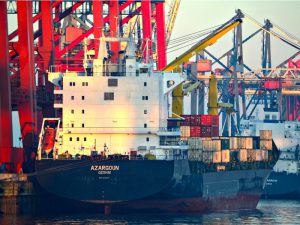
MARCH 18, 2016—The 2,500-TEU containership Azargoun called at the Port of Hamburg on March 17, signaling the reopening of Islamic Republic of Iran Shipping Lines’ “European Container Line” (ECL) between Northern Europe
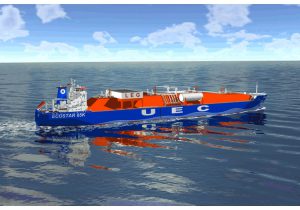
Tucked away in southwestern Finland is Salo, a town of about 50,000, where 40 percent of all the doors for large cruise ships are produced. Antti Marine’s production facility in Salo has produced a quarter of a million doors for 300 cruise ships in just over 20 years. It takes about 10 weeks to produce a typical order of 3,000 doors. They are supplied over a period of six months, as and when the ship’s cabins are built
“We are devoted to lean thinking,” says Commercial Director Markko Takkinen. “The production time of the doors is short, as we do not want them remain in storage here.”
Antti Marine specializes in what it calls ‘“tailored mass production”—necessary because on one cruise ship there may be 150 different types of doors.
Antti Marine is not the only Finnish marine company that benefits from many of the world’s large cruise ship fleet being built in Finland.
Cruise ships also have a lot of toilets and a need for a lot of waste management systems. Finnish headquartered Evac Group has just received its biggest cruise vessel contract ever: total waste management systems for four large cruise ships plus an option to outfit an additional six vessels. The initial four-vessel contract is valued at about EURO 30 million.
Each ship will have an Evac Cleansea wastewater treatment plan, allowing operation in Environmentally Sensitive Sea Areas (ESSAs) and Special Areas (SAs), dry and wet waste treatment systems, a bio sludge treatment unit, plus vacuum collecting systems and some 3,000 vacuum toilets.
Evac also supplies its products to a wide range of users ashore and afloat. So, too, does fire protection specialist Marioff Corporation Oy, but its roots are in the marine market and it last year launched a new generation Hi-Fog 3000 sprinkler series for marine applications that replaces earlier Hi-Fog 1000 and Hi-Fog 2000 sprinkler series.
“With the launch of this new generation of Hi-Fog 3000 sprinklers, we are offering to our marine customers enhanced Hi-Fog systems with faster activation, more efficient suppression and improved passenger and crew safety,” says John Hemgård, Director of Marine Business, Marioff Corporation Oy.
The Hi-Fog 3000 sprinkler series is designed, tested and type approved according to IMO Res.A800(19) as amended in IMO Res.MSC.265(84).
Another Finnish product that really took off after its widespread adoption is ABB’s Azipod. It’s become the propulsor of choice for cruise ships and ABB is currently delivering the complete electrical power plant and propulsion systems for two new 3,300 passenger cruise ships building at Germany’s Meyer Werft. The 20.5 MW Azipod XO propulsion unit for the first of the ships recently left the ABB factory in Helsinki.
ABB has delivered, or has on order, Azipod propulsion units for about 200 vessels
Each Azipod propulsion unit takes about two months for technicians to assemble at ABB’s Vuosaari plant. Across town at ABB’s Helsinki motors, generators and drives factory, the powerful synchronous motors at the system’s core take shape over six months.
COOPERATION AMONG STAKEHOLDERS
The major driver for marine engine designers is bringing engines into compliance with emissions requirements while keeping fuel consumption and maintenance costs under control.
A new pressurized EGR (exhaust gas recovery) economizer from Alfa Laval shows how Scandinavian maritime innovation often results from a cooperation between suppliers, university departments and shipowners. It also illustrates that, for some ships, EGR may be a better means of coming into compliance with new NOx limits than the better known SCR (selective catalytic reduction).
In a project supported by the Danish Energy-Technological Development and Demonstration Program (EUDP) and developed in cooperation with Aalborg University, the EGR economizer has been rigorously tested aboard the containership Maersk Cardiff.
“As a front-runner in the pursuit of green technologies, we were keen to see what the Aalborg EGR-HPE could do,” says Ole Christensen, Senior Machinery Specialist at A.P. Moller-Maersk. “But while we were enthusiastic about the boiler’s potential, we were also somewhat uncertain as how it would handle the physical realities of EGR. The temperatures are twice as high as those of traditional waste heat recovery, and the gas pressures are far greater.”
Those concerns disappeared when the boiler was brought online with the Maersk Cardiff’s two-stroke MAN B&W 6S80ME-C9 engine in November 2014. “Not only did the boiler survive,” says Christensen, “[but also] the results we have seen during testing are very promising.”
“EGR provides Tier III NOx compliance with a very compact footprint, but compliance itself is only part of the full potential,” says John Pedersen, Business Manager, Boilers, Combustion & Heaters at Alfa Laval. “Working closely with MAN Diesel & Turbo to optimize the EGR technology, we saw additional opportunities through our expertise in marine boilers.”
In the EGR process, around 30% of the exhaust gas is directed back into the engine, which reduces the combustion temperature and thus the production of NOx. Since only the remaining 70% of the gas reaches the traditional exhaust gas boiler after the turbocharger, waste heat recovery is reduced by 30% as well.
The Aalborg EGR-HPE is a revolutionary new economizer enclosed in a pressure casing that is placed in-line ahead of the pre-scrubber sprayers in the EGR circuit.
“By moving the break point for waste heat recovery from a medium engine load down to a low load, the Aalborg EGR-HPE enables even slower steaming,” says Pedersen. “That means fuel savings that quickly pay back the economizer, offset the EGR investment and lower CO2 emissions on top of the NOx reduction.”
 Positioned ahead of the pre-scrubber spray jets, the Aalborg EGR-HPE has access to much higher temperatures than traditional exhaust gas boilers. It is integrated with the conventional waste heat recovery after the turbocharger by its steam drum, which is shared with the traditional exhaust gas boiler. With the output of the traditional economizer feeding into the shared drum, the Aalborg EGR-HPE produces extremely high-quality steam with a temperature of just above 400°C, bringing the waste heat recovery system to a much higher level of efficiency.
Positioned ahead of the pre-scrubber spray jets, the Aalborg EGR-HPE has access to much higher temperatures than traditional exhaust gas boilers. It is integrated with the conventional waste heat recovery after the turbocharger by its steam drum, which is shared with the traditional exhaust gas boiler. With the output of the traditional economizer feeding into the shared drum, the Aalborg EGR-HPE produces extremely high-quality steam with a temperature of just above 400°C, bringing the waste heat recovery system to a much higher level of efficiency.
Using the Aalborg EGR-HPE in an integrated system allows waste heat recovery to occur at lower main engine loads than possible with a traditional waste heat recovery system in Tier III operation. This creates the possibility of even slower steaming.
“The EGR economizer makes waste heat recovery beneficial at far lower engine loads, down to around 30%” says Pedersen. “This means that vessels can steam even slower, with huge fuel savings as a result.”
DUAL FUEL
B&W in MAN-B&W stands for Burmeister & Wain and the Burmeister & Wain shipyard in Copenhagen built the Selandia, the world’s first successful diesel-powered oceangoing ship. That was in 1912.
More than a century later MAN Diesel & Turbo in Copenhagen is still on the cutting edge of diesel innovation.
One beneficiary of this is TOTE Maritime which opted for MAN Diesel & Turbo dual fuel technology for its two new Marlin Class, Jones Act containerships. Both of these ships have been delivered for operation between the U.S. and Puerto Rico, burning LNG as fuel and thereby meeting all U.S. SECA emissions requirement. Each is powered by the world’s first dual-fuel slow-speed engine, an MAN-B&W 8L70ME-GI, built in Korea by licensee Doosan Engine.
The technology in the ME-GI engines wasn’t just pulled out of a hat. It is a natural development of the MAN B&W low speed electronically controlled ME family of engines. The first testing of the GI principles was carried out in 1987 and MAN Diesel
& Turbo introduced its first two-stroke ME-GI dual fuel engine series in 2011, adding the ME-LGI engine series (which can burn liquid fuels such as methanol and ethanol) in 2013.
In theory, any ME engine can be converted into an ME-GI engine, but to be recognized by a classification society as “LNG ready” an ME engine equipped newbuild will have to be designed with provision for such things as the necessary LNG fuel tanks, piping and other ancillaries.
MEDIUM SPEEDS, TOO
LNG fueling has also proved an attraction for many operators of vessels with medium speed diesels who have to operate in emissions control area.
That trend sees Wärtsilä set to deliver the 100th Wärtsilä 34DF dual-fuel marine engine from the factory in early 2016. It is part of an order for three new large escort tugs under construction for Norwegian operator Østensjø Rederi by Spanish shipbuilder Astilleros Gondan. The tugs will operate at Statoil’s Melkøya terminal near Hammerfest in Norway.
“These 100 engines do not include those delivered for land-based energy generation applications,” says Lars Anderson, Vice President, Wärtsilä Marine Solutions.
“Within its power range, the Wärtsilä 34DF has become the workhorse of the marine industry, thanks to its superior reliability and lower operating costs. It is a highly efficient engine that is also making a notable contribution to environmental compliance,”
The Wärtsilä 34DF dual-fuel engine was upgraded in 2013 with a higher MCR (maximum continuous rating) and better efficiency than its earlier version, the first of which was delivered in 2010. The upgraded version has a power output range from 3,000 to 10,000 kW at 500 kW per cylinder.
ELIMINATE THE ENGINE?
Of course, if you can eliminate the engine and switch to battery power, that gets rid of emissions issues entirely. One area where this could be possible is in certain short range ferry operations and we have already noted the E-ferry way project under way in Denmark at Søby Værft AS.
 Wärtsilä, too, is eyeing this niche. In January it launched a concept for a series of zero or low emission shuttle ferries. The concept has been developed in line with new Norwegian environmental regulations for ferries, and Wärtsilä says this regulatory trend is also evident in other countries.
Wärtsilä, too, is eyeing this niche. In January it launched a concept for a series of zero or low emission shuttle ferries. The concept has been developed in line with new Norwegian environmental regulations for ferries, and Wärtsilä says this regulatory trend is also evident in other countries.
The ferries are designed to run entirely on batteries or in a battery-engine hybrid configuration where the fuel options are liquefied natural gas (LNG) or biofuel.
In plug-in operation, the fuel consumption is reduced by 100 percent compared to conventional installations, and all local emissions are completely eliminated. With the plug-in hybrid configuration, emissions are reduced by up to 50 percent.
The concept features Wärtsilä’s new wireless inductive charging system, which offers major benefits for typical shuttle ferry operations involving 20,000 or more departures a year because of its time and energy savings. The system eliminates physical cable connections, thus reducing wear and tear and enabling charging to begin immediately when the vessel arrives at quay.
Wärtsilä has now signed an agreement with Cavotec SA to jointly develop a combined induction charging and automatic mooring concept. It would incorporate Wärtsilä’s wireless induction power transfer into a vacuum-based automated mooring technology in which remote controlled vacuum pads recessed into, or mounted on the quayside, moor and release vessels in seconds.
FILTER PROMISES TO CUT NOX
The Exilator, an environmental filter for smaller ships, able to reduce both sulfur, carbon monoxide, NOx and noise, has been successfully tested on a Danish Maritime Authority ship. The technology has been testing over a 12-month project phase followed by a three-month practical test of the concept on the Danish Maritime Authority’s ship Poul Løwenørn. The filter’s performance has been documented by the Danish Technological Institute, and the installation and mounting of the filter has been approved by LR.
The filter has been designed for ships with engines of up to 6 MW. Current regulations don’t require the cleaning of exhaust gas from smaller ships if they already sail on marine diesel with a maximum sulfur content of 0.1%. Still, developer Exilator ApS
believes that there is already a market for the filter, as it reduces soot pollution and NOx on the ship itself and also cuts engine noise considerably — particularly attractive in the yachting sector, or expedition vessels sailing in very sensitive nature areas.
According to the test from the Danish Technological Institute, the filter reduces soot particle emissions by 99,1%, carbon monoxide by 98% and NOx by 11%. Though those tests didn’t cover the filter’s noise reduction properties but the company expects a noise reduction up to 35 dB, including low frequency noise.
Financing for development and testing was secured through the Danish Growth Fund and investment & development company CapNova.
The filter works by catalytically incinerated the soot in the exhaust as soon the ship’s engines reach exhaust temperatures above 325 degrees C. Ash is accumulated in the filter, which means that the filters must be cleaned after about 5,000 operational hours, as part of the recycling process.
The filter requires that the ship uses marine gas oil with a maximum sulfur content of 0.1%. According the test, the filter improves the ship’s fuel consumption by around 1%.
The exhaust gas, after passing through the turbo charger, goes to a muffler that removes the deep resonance. Then comes the particle filter, which also serves as an oxidation catalyst, where the soot is captured and burned – and finally the gas is led through a reducing catalyst, which minimizes NOx and NO2, before being emitted into the atmosphere.
Development is now underway in a collaboration with DTU, the Technological Institute and an engine manufacturer aimed at increasing the filter’s NOx reduction from 11% to 40% in phase 1, and to 80% in the subsequent phase 2. When this is achieved, the filter will enable compliance with IMO Tier III NOx limits.
SCRUBBERS
Shipowners face no shortage of options if they decide to use exhaust gas scrubbers to cut sulfur emissions. Recent customers for Alfa Laval’s PureSOx exhaust gas cleaning systems include Buss Shipping, which is retrofitting hybrid PureSOx systems on two 1,025 TEU container feeder ships that operate exclusively in Emission Control Areas (ECAs). Since they frequent the low-alkalinity waters between Rotterdam and St. Petersburg, as well as ports like Hamburg with zero-discharge requirements, a scrubber with closed-loop mode was a necessity.
Each ship will receive a hybrid PureSOx system with multiple inlets, connecting the main engine and two auxiliary engines to one U-design scrubber. In contrast to earlier systems with multiple inlets, the inlets will now lead into a single scrubber jet section – an advance in construction that will make the scrubber even more compact.
“The PureSOx solution was well engineered and allowed a sophisticated integration of the scrubber system into our container feeder ships,” says Christoph Meier, Project Manager, Buss Shipping. “The custom construction let us avoid major modifications inside the vessel, which together with the pre-outfitting gave us a short installation time. All those factors contributed to a competitive price.”
Though there’s no doubt that scrubbers work, they also involve a substantial investment. That led Finland’s family-owned Langh Ship to develop a scrubber of its own, the decision was made a little easier by the fact that another family-owned company has 40 years’ experience in cleaning washing waters.
The resulting product was successfully tested over an extended period on one of Langth’s own ships, the M/S Laura, and received final class approval from GL in August 2014. All of Langh’s five vessels have now been fitted with the scrubber and last year a hybrid version was installed on Bore Shipping’s M/V Bore Song.
“It has lived up to our expectations: minimum sludge handling, very clean outgoing water and in that respect minimum impact on the environment,” said Jörgen Mansnerus, VP, Marine Management at Bore Ltd.
Scrubbers could become less expensive as the result of a pilot project developed by Norwegian University of Science and Technology (NTNU) researchers Carlos Dorao and Maria Fernandino.
Called the Lynx Separator, the technology now being examined for possible use in marine exhaust gas scrubbers was originally developed for use in the natural gas industry and involves using a steel sponge along with centrifugal force to remove the fluid from a gas stream, offering a brand new solution for the gas industry.
In the Lynx Separator, wet gas flows through the separator. A tubular metal sponge spins rapidly so the liquid is separated from the gas and thrown to the side and down, allowing dry gas to stream up to where it’s needed.
The Research Council of Norway’s Innovation Program MAROFF (Maritime activities and offshore operations) has now funded a pilot project to examine the possibility of applying the separator technology to cleaning ships’ exhaust emissions from ships andetheoretical calculations and testing show promising results
BALLAST WATER MANAGEMENT SYSTEMS
Another major focus of compliance concern for shipowners is, of course, ballast water management. Needless to say, most of the major players in the Scandinavian marine equipment sectors have horses in this race. It’s just to soon to pick any winners given the fact that no system has yet gained full U.S. Type Approval.
As this was written, Norway’s Optimarin was claiming to be on the brink of the coveted approval and was pleased when the U.S. Coast Guard told manufacturers of ultraviolet (UV) based BWMS that it will not accept the Most Probable Number (MPN) testing method in its approval process. The MPN methodology evaluates organisms on the basis of “viable/unviable,” with most UV systems depositing “unviable” organisms back into the water – meaning they are still alive but cannot reproduce. The USCG said that the FDA/CMFDA test, which judges life forms as “living/dead,” must be the standard for approval.
Optimarin says the decision is good news.
The Coast Guard has told UV system manufacturers that it will not accept the Most Probable Number (MPN) testing method in its approval process. The MPN methodology evaluates organisms on the basis of “viable/unviable,” with most UV systems depositing “unviable” organisms back into the water – meaning they are still alive but cannot reproduce.
“This is a clear indication to the industry that USCG wants absolute certainty with regard to standards – they do not want living organisms deposited in their territory,” comments Tore Andersen, Optimarin’s CEO. “MPN is acceptable for IMO, but that won’t be any consolation to shipowners with global fleets that want the flexibility of sailing in and out of U.S. waters.”
He says that Optimarin, which has over 20 years of industry experience and installed the world’s first commercial BWT system in 2000, is the only UV manufacturer that is currently within “touching distance” of USCG approval.
Its technology successfully satisied the FDA/CFMDA criteria during testing last year. Further tests in other water salinities are scheduled for spring 2016, after which point approval is expected later this year.
Andersen says the system’s power is the key to its efficacy. “Each of our system lamps has a 35 kW capacity, which is huge for a UV system. That power instantly kills invasive organisms and that’s exactly what USCG wants to see,” he says
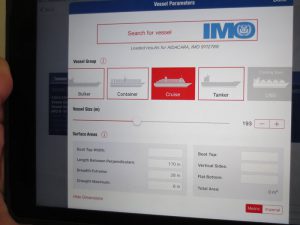
MARCH 11, 2016 — AkzoNobel says its marine coatings business has added cruise vessels to Intertrac Vision, its “big data” tool designed to provide accurate and transparent predictions on the fuel and
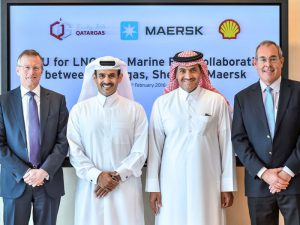
FEBRUARY 22, 2016 — Qatargas, the Maersk Group and Shell have signed a Memorandum of Understanding (MOU) to explore the development of LNG as a marine fuel in the Middle East region.
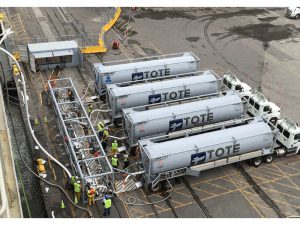
Last year, General Dynamics NASSCO earned the bragging rights for building and delivering the world’s first LNG-fueled containership, the Isla Bella, to Jones Act operator TOTE Maritime. The San Diego shipbuilder capped off that technological achievement last month by delivering the 764 ft Perla del Caribe, sister ship to the Isla Bella, two months early.
The two ships were built under a contract signed by TOTE in December 2012. The investment by TOTE in the two ships was $375 million.
TOTE President and CEO Anthony Chiarello, says that the “Isla Bella is already serving the people and communities of Puerto Rico and we are excited to introduce the Perla Del Caribe into the trade next month.”
GD NASSCO designed the ships in partnership with DSEC, a subsidiary of Daewoo Shipbuilding & Marine Engineering (DSME), located in Busan, South Korea.
The design is based on proven containership-design standards and includes DSME’s patented LNG fuel-gas system and a MAN ME-GI dual fuel, slow-speed engine. The 8L70ME-GI engine was built by Korea’s Doosan Engine under license from MAN Diesel & Turbo.
Burning LNG will allow the Marlin Class ships to be fully compliant with strict emissions regulations while operating in both the North American Emissions Control Area and the U.S. Caribbean ECA.
The Isla Bella made its first trip from Jacksonville, FL, to San Juan, Puerto Rico, November 24.
 On January 9, TOTE Maritime Puerto Rico successfully loaded LNG bunkers aboard the world’s first LNG powered containership, MV Isla Bella. Approximately 100,000 LNG gallons transported by 12 TOTE-owned LNG ISO containers were loaded on schedule. The bunkering was conducted under strict U.S. Coast Guard oversight while Isla Bella was also undergoing cargo operations.
On January 9, TOTE Maritime Puerto Rico successfully loaded LNG bunkers aboard the world’s first LNG powered containership, MV Isla Bella. Approximately 100,000 LNG gallons transported by 12 TOTE-owned LNG ISO containers were loaded on schedule. The bunkering was conducted under strict U.S. Coast Guard oversight while Isla Bella was also undergoing cargo operations.
The LNG was transferred from the ISO tank containers using a specially developed transfer skid developed by TOTE’s partner Applied Cryogenics Technologies (ACT) of Houston, TX. The transfer skid is designed to allow four ISO tanks to be transferred to Isla Bella at once, dramatically reducing transfer time.
The LNG was sourced by TOTE’s partner, JAX LNG, LLC, from AGL Resources’ LNG production facility in Macon, GA. Genox Transportation, a specialized LNG trucking partner of TOTE, transported the fuel to Jacksonville. Pivotal LNG, a subsidiary of AGL Resources, also provided transfer expertise to TOTE Maritime with its highly trained LNG experts, ensured the operation was conducted safely and in accordance with best industry practices.
Oversight of the operation both at shipside and on shore was provided by TOTE Services, Inc. (TSI), TOTE Maritime’s sister company that manages the vessels.
“We are very pleased with the results of this initial LNG bunker event and know that the use of LNG in our Marlin Class vessels will provide unprecedented environmental benefits both here in Jacksonville and in Puerto Rico,” says Tim Nolan, President of TOTE Maritime Puerto Rico. “We are indebted to USCG Sector Jacksonville for their diligent oversight and assistance that was invaluable and helped make this event a success. Our partners ACT, Pivotal LNG and Genox were also major components of our success. Our sister company, TSI, has developed significant expertise in LNG as a Maritime fuel and ensures that our vessels operate safely and efficiently using this environmentally superior fuel.”
Applied CryoTechnologies, Inc. (ACT) is the premier equipment supplier for cryogenics in North America. ACT is proud to be the first to market with this type of bunkering equipment for the marine industry. Leveraging ACT’s innovative style and unrivaled experience in LNG equipment is sure to bring success to any LNG fueling project.
Pivotal LNG brings liquefied natural gas to companies and industries throughout the United States through reliable, flexible and cost-effective solutions.
TOTE Maritime provides safe, reliable transportation at the fastest speed possible for the Puerto Rican and related Caribbean trades.
Meanwhile, Crowley Puerto Rico Services, Inc., Jacksonville, has selected Eagle LNG Partners as LNG supplier for the company’s new LNG-powered, Commitment Class ships, which will be delivered in 2017 for use in the U.S. mainland to Puerto Rico trade. To support Crowley’s LNG needs, Eagle LNG will build an LNG plant offering a capacity of 200,000 gallons per day (87,000 gallons per day initially) in Jacksonville. The state-of-the-art facility is slated to be operational by early 2017. The decision to partner with Eagle LNG was made by Crowley in part because of the companies’ shared commitment to the environment.
“Crowley is proud to take a leadership position in the industry’s shift to cleaner-burning, natural gas fuel solutions,” said Crowley’s John Hourihan, senior vice president and general manager, Puerto Rico services. “The partnership with Eagle LNG is an important first step in developing sustainable supply infrastructure to ensure these highly technical, environmentally friendly vessels operate to their full capability.”
“The marine sector represents a significant opportunity for LNG fueling in the U.S., and Eagle LNG is well-positioned to build the necessary infrastructure and provide the specialized logistics to facilitate this energy transformation,” said Dick Brown, CEO, Eagle LNG. “It takes companies like Crowley to lead that wave of change. Eagle LNG is proud to work with such a pioneering organization.”
“This project is an important investment in our community from both economic and environmental perspectives,” said Jacksonville Mayor Lenny Curry. “It clearly demonstrates the leadership role our region is playing in LNG development and progression, while strengthening our commitment to leaving a smaller footprint through cleaner-burning fuel.”
The supply agreement between Eagle LNG and Crowley will provide LNG fuel for the El Conqui and Taino, which are expected to be in service in the second quarter and fourth quarter of 2017 respectively. The Jones Act ships will replace Crowley’s towed triple-deck barge fleet, which has served the trade continuously and with distinction since the early 1970s. These new ships, will offer customers fast ocean transit times, while accommodating the company’s diverse equipment selection and cargo handling flexibility – benefits customers have enjoyed for nearly 60 years. The LNG plant is separate from the previously announced Eagle LNG Federal Energy Regulatory Commission (FERC) export terminal located along the St. Johns River, in Jacksonville, which will continue to focus on export markets in the Caribbean and Atlantic Basin.
DUAL FUEL BULKERS BUILT TO NEW DNV GL CLASS
ESL Shipping’s new dual-fuelled bulk carriers will not only be the first large LNG-fuelled bulkers, but the first vessels constructed to the new DNV GL rule set. Due for delivery in early 2018, the two highly efficient 25,600 dwt vessels are optimized for trading in the Baltic Sea region.
“It is fitting that the first vessels that will be constructed to the most forward looking set of classification rules are themselves at the cutting edge of maritime innovation,” says Knut Ørbeck-Nilssen, CEO of DNV GL – Maritime. “We have created these rules to be ready for the future and we have long pioneered the use of LNG as a ship fuel. To see these two come together in a double first for the industry is a remarkable moment. We look forward to working with ESL, Deltamarin, Sinotrans & CSC Qingshan Shipyard and all the project partners to make this project a success.”
“We are proud to be the world’s first shipyard applying the new and innovative DNV GL rules for a newbuilding, just two months after DNV GL has launched its new rules in October this year,” said Liu Guangyao, Deputy General Manager of Sinotrans & CSC at the Marintec China Trade Fair recently. “We appreciate the support that DNV GL has committed to provide on the project during both the design and construction phase, especially in a project with many advanced extra class notations. We are looking forward to a close cooperation and a successful delivery.”
Featuring the Deltamarin B.Delta26LNG design, the two highly efficient ships will feature dual-fuel main and auxiliary machinery, resulting in CO2 emissions per ton of cargo transported half that of present vessels. The bulk carriers will be built to the new DNV GL rules for general dry cargo ships with DNV GL ice class 1A and will have type C LNG tanks of approximately 400 m3 capacity enabling bunkering at several terminals within the Baltic region. The B.Delta26LNG has a shallow draft of maximum 10 m, an overall length of 160 m, and a breadth of 26 m.
“We are very excited to have been selected to take part in this ground breaking project,” says Morten Løvstad, Business Director Bulk Carriers at DNV GL. “Being asked to work with such an innovative team as the classification partner is a testament to the creativity and hard work that so many colleagues at DNV GL have invested in the new rule set. These vessels will set new standards for efficiency and environmental performance. They are an important step forward in showing how shipping can be a force for sustainability today and in the future.”
FIRST PURE LNG FERRY FOR GERMANY
Germany’s first LNG-fueled ferry, the MS Ostfriesland, has now been operating for AG Ems between Emden and Borkum Island on the ecologically sensitive Wadden Sea, since June 2015.
Originally built in 1985, the vessel was converted to dual fuel propulsion in a conversion that saw it fitted with a complete new aft end, construction of which got underway at German shipyard Brenn – und Verformungstechnik Bremen GmbH while the ship remained in service.
The new aft section, which extended the vessel’s length from 78.7 m to 93 m, houses the new machinery space and LNG fuel system/tank with the vessel now being propelled by two electrically powered Schottel STP Twin thrusters, each rated at 1,150 kW at 1,480 rpm.
While the prime movers are two 6-cylinder Wärtsilä 20DF dual-fuel generating sets, for navigating within harbors, the vessel uses two Mitsubishi auxiliary generators.
Switching to LNG fuel means providing against various unlikely malfunctions, such as an ignition failure resulting in an unburned mixture of gas and air in the exhaust. This could cause uncontrolled combustion and an increase in pressure the next time ignition takes place, putting a substantial strain on the pipe components.
To protect against this, the Mitsubishi auxiliary generators are protected by a Q-Rohr flameless venting system by German manufacturer Rembe GmbH that ensures that the reaction is vented directly at the exhaust.
Both the flame and the pressure are absorbed by the stainless steel mesh filter of the Q-Rohr, providing optimum protection for the pipe components and the environment.
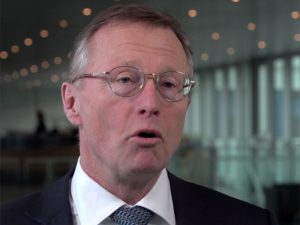
FEBRUARY 10, 2016 — The Maersk Group has published its 2015 Annual Report. With a loss-making fourth quarter, the group delivered a profit of $925 million, compared to the prior year’s $5.2